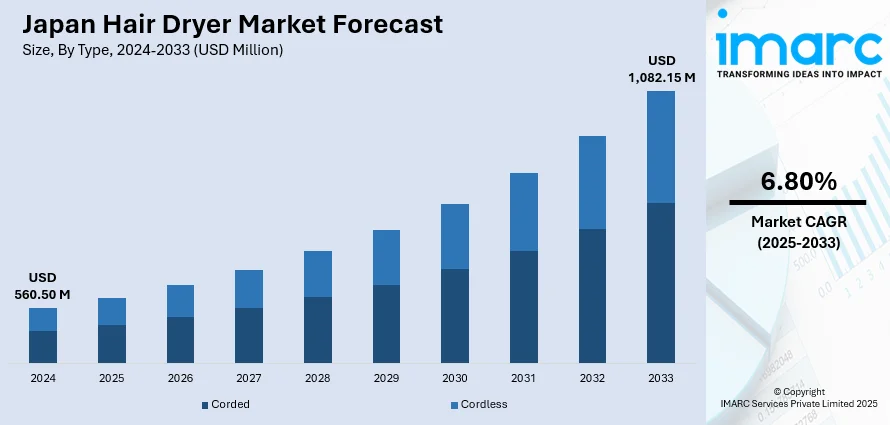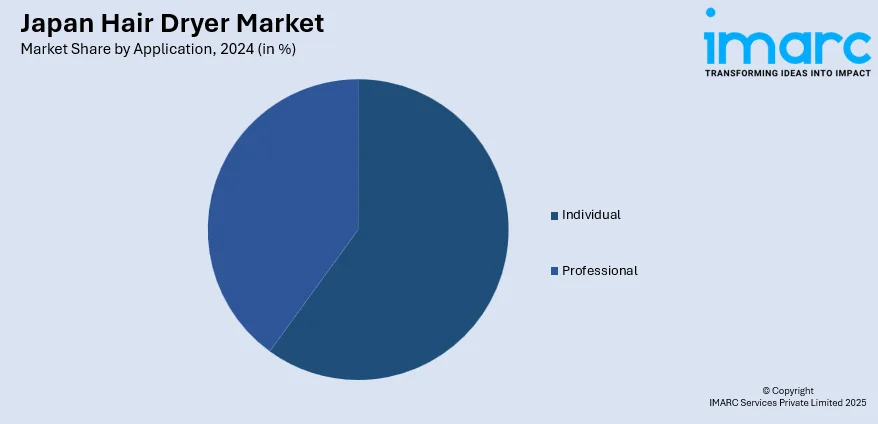
Japan Hair Dryer Market Size, Share, Trends and Forecast by Type, Application, Distribution Channel, and Region, 2025-2033
Japan Hair Dryer Market Overview:
The Japan hair dryer market size reached USD 560.50 Million in 2024. Looking forward, IMARC Group expects the market to reach USD 1,082.15 Million by 2033, exhibiting a growth rate (CAGR) of 6.80% during 2025-2033. The market is driven by increasing consumer demand for high-tech hair dryers with features such as ionic technology and AI temperature control, which minimize heat damage while enhancing efficiency. Additionally, the shift toward sustainability is accelerating sales of energy-efficient, eco-friendly models, supported by government incentives and Japan’s circular economy initiatives. These trends, coupled with rising preference for salon-grade at-home haircare, is further augmenting the Japan hair dryer market share.
|
Report Attribute
|
Key Statistics
|
|---|---|
|
Base Year
|
2024
|
|
Forecast Years
|
2025-2033
|
|
Historical Years
|
2019-2024
|
| Market Size in 2024 | USD 560.50 Million |
| Market Forecast in 2033 | USD 1,082.15 Million |
| Market Growth Rate 2025-2033 | 6.80% |
Japan Hair Dryer Market Trends:
Rising Demand for High-Tech Hair Dryers with Advanced Features
The market is experiencing a rise in demand for high-tech models equipped with advanced features such as ionic technology, infrared heat, and AI-powered temperature control. Consumers are increasingly seeking devices that minimize heat damage, reduce drying time, and enhance hair health. Brands are leading this trend by introducing lightweight, energy-efficient dryers with customizable settings. In 2023, Japan witnessed its total energy consumption fall by 3.5%, at 391 Mtoe, with per capita electricity consumption at 7.3 MWh and energy self-reliance standing at only 16.5%, while it points towards continued dependence on imports and high energy costs. These advances highlight the imperative need for energy-efficient switches to help Japanese manufacturers reduce operating expenses. Additionally, the growing popularity of salon-quality at-home hair care has driven sales of premium hair dryers with ceramic and tourmaline components, which help reduce frizz and static. The market is also seeing an uptick in smart hair dryers that connect to mobile apps for personalized drying routines. As Japanese consumers prioritize convenience and hair protection, manufacturers are expected to continue innovating with cutting-edge technologies to meet these changing preferences.

Shift Toward Sustainable and Eco-Friendly Hair Dryers
Consumers showing a strong preference for eco-friendly models is supporting the Japan hair dryer market growth. Energy-efficient hair dryers with low power consumption and recyclable materials are gaining traction as environmental awareness grows. The OECD’s Environmental Performance Review of Japan 2025 highlights progress in emissions and waste reduction, with greenhouse gas emissions down 19% since 2013 and a municipal waste level two-thirds lower than the OECD average. However, Japan is facing growing pressure to phase out fossil fuels and improve recycling, especially plastics, to meet its target of net zero by 2050. Such essential changes provide new avenues for Japan's hair dryer industry to use eco-friendly materials and contribute to the nation's sustainability goals as well. Brands are responding by adopting greener manufacturing processes and reducing plastic usage in packaging. Furthermore, there is increasing demand for durable, long-lasting dryers that minimize electronic waste, aligning with Japan’s push toward a circular economy. Some companies are also introducing solar-powered or biodegradable hair dryers to appeal to eco-conscious buyers. Government incentives promoting energy-saving appliances further support this trend. As sustainability continues to influence purchasing decisions, manufacturers are likely to invest more in R&D to develop environmentally responsible hair dryers without compromising performance. This shift reflects Japan’s broader commitment to reducing carbon footprints in consumer electronics.
Japan Hair Dryer Market Segmentation:
IMARC Group provides an analysis of the key trends in each segment of the market, along with forecasts at the country and regional levels for 2025-2033. Our report has categorized the market based on type, application, and distribution channel.
Type Insights:
- Corded
- Cordless
The report has provided a detailed breakup and analysis of the market based on the type. This includes corded and cordless.
Application Insights:

- Individual
- Professional
A detailed breakup and analysis of the market based on the application have also been provided in the report. This includes individual and professional.
Distribution Channel Insights:
- Online
- Offline
The report has provided a detailed breakup and analysis of the market based on the distribution channel. This includes online and offline.
Regional Insights:
- Kanto Region
- Kansai/Kinki Region
- Central/ Chubu Region
- Kyushu-Okinawa Region
- Tohoku Region
- Chugoku Region
- Hokkaido Region
- Shikoku Region
The report has also provided a comprehensive analysis of all the major regional markets, which include Kanto Region, Kansai/Kinki Region, Central/ Chubu Region, Kyushu-Okinawa Region, Tohoku Region, Chugoku Region, Hokkaido Region, and Shikoku Region.
Competitive Landscape:
The market research report has also provided a comprehensive analysis of the competitive landscape. Competitive analysis such as market structure, key player positioning, top winning strategies, competitive dashboard, and company evaluation quadrant has been covered in the report. Also, detailed profiles of all major companies have been provided.
Japan Hair Dryer Market News:
- August 06, 2024: Panasonic introduced a new series of nanoe hair dryers featuring moisture-balancing technology. These Asia-Pacific region-specific dryers are expected to capitalize on a rapidly growing market, projected to reach USD 709 Million by 2029, up from USD 480 Million.
Japan Hair Dryer Market Report Coverage:
| Report Features | Details |
|---|---|
| Base Year of the Analysis | 2024 |
| Historical Period | 2019-2024 |
| Forecast Period | 2025-2033 |
| Units | Million USD |
| Scope of the Report |
Exploration of Historical Trends and Market Outlook, Industry Catalysts and Challenges, Segment-Wise Historical and Future Market Assessment:
|
| Types Covered | Corded, Cordless |
| Applications Covered | Individual, Professional |
| Distribution Channels Covered | Online, Offline |
| Regions Covered | Kanto Region, Kansai/Kinki Region, Central/ Chubu Region, Kyushu-Okinawa Region, Tohoku Region, Chugoku Region, Hokkaido Region, Shikoku Region |
| Customization Scope | 10% Free Customization |
| Post-Sale Analyst Support | 10-12 Weeks |
| Delivery Format | PDF and Excel through Email (We can also provide the editable version of the report in PPT/Word format on special request) |
Key Questions Answered in This Report:
- How has the Japan hair dryer market performed so far and how will it perform in the coming years?
- What is the breakup of the Japan hair dryer market on the basis of type?
- What is the breakup of the Japan hair dryer market on the basis of application?
- What is the breakup of the Japan hair dryer market on the basis of distribution channel?
- What is the breakup of the Japan hair dryer market on the basis of region?
- What are the various stages in the value chain of the Japan hair dryer market?
- What are the key driving factors and challenges in the Japan hair dryer market?
- What is the structure of the Japan hair dryer market and who are the key players?
- What is the degree of competition in the Japan hair dryer market?
Key Benefits for Stakeholders:
- IMARC’s industry report offers a comprehensive quantitative analysis of various market segments, historical and current market trends, market forecasts, and dynamics of the Japan hair dryer market from 2019-2033.
- The research report provides the latest information on the market drivers, challenges, and opportunities in the Japan hair dryer market.
- Porter's five forces analysis assist stakeholders in assessing the impact of new entrants, competitive rivalry, supplier power, buyer power, and the threat of substitution. It helps stakeholders to analyze the level of competition within the Japan hair dryer industry and its attractiveness.
- Competitive landscape allows stakeholders to understand their competitive environment and provides an insight into the current positions of key players in the market.
Need more help?
- Speak to our experienced analysts for insights on the current market scenarios.
- Include additional segments and countries to customize the report as per your requirement.
- Gain an unparalleled competitive advantage in your domain by understanding how to utilize the report and positively impacting your operations and revenue.
- For further assistance, please connect with our analysts.
 Request Customization
Request Customization
 Speak to an Analyst
Speak to an Analyst
 Request Brochure
Request Brochure
 Inquire Before Buying
Inquire Before Buying




.webp)




.webp)












